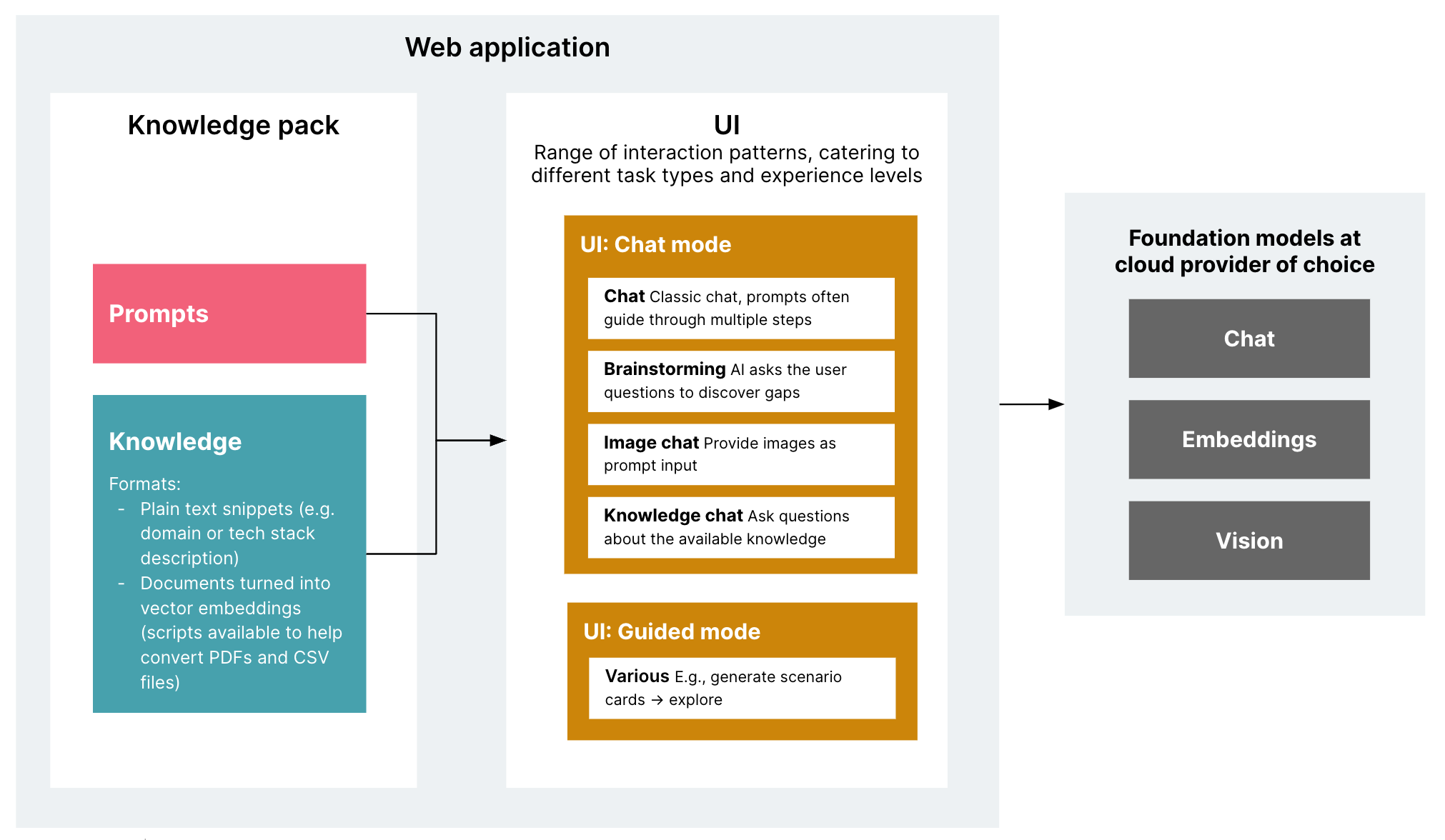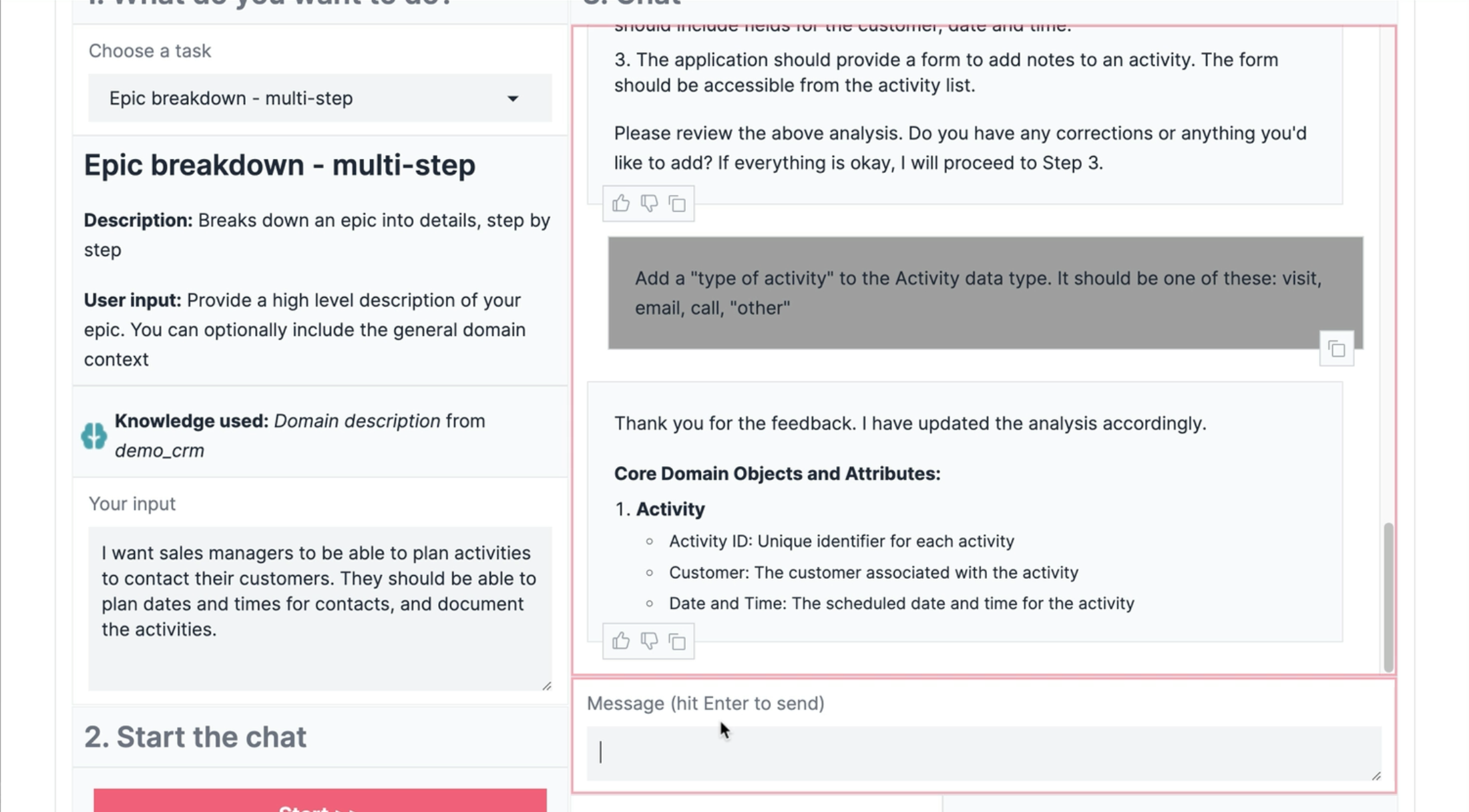Thoughtworks is a global software consultancy working for a wide range of clients. We're using Haiven as an accelerator to offer our clients a lean way to pilot the use of AI assistance for software delivery teams while the market of products is still busy and evolving.
A sandbox to lower the barrier to experiment with the use of Generative AI assistance for software delivery tasks beyond coding.
- Simple one-container deployment --> easy to deploy in your environment
- Integratable with the 3 big cloud provider's model services (Azure OpenAI, Google Gemini, AWS Bedrock) --> choose your existing cloud provider of choice to alleviate at least some of the data confidentiality concerns that currently limit many enterprise's choice of product and tool usage
- Separation of application and "knowledge pack" to plug in and change your own prompts and domain information --> customize to your team, and potential to reuse what you develop in the knowledge pack in other AI tools
- A product
- A fully fleshed out and scalable tool
More on the why here, in particular these two questions:
- Why would you use it?
- How does it compare to...?
Haiven lets you codify your practices and knowledge and make it available to an AI assistant, to surface it to team members just-in-time when they are working on a task.
Disclaimer: As the majority of developers in Thoughtworks are using MacOS, all shell-related instructions are currently only build for and tested on MacOS.
Prerequisite:
- Log into the GitHub Container Registry:
echo $CR_PAT | docker login ghcr.io -u USERNAME --password-stdin(documentation about how to get a token and authorize yourself here)
- Create a
.envfile with the content of (app/.env.azure.template)[app/.env.azure.template] - Change the
AZURE_OPENAI_API_KEYin that file to the API Key - (Thoughtworkers can ask the Haiven team for access to the "trial" Azure OpenAI API Key).
mkdir haiven
cd haiven
# Put the .env file into this new folder
git clone git@github.com:tw-haiven/haiven-tw-knowledge-pack.git
# The TW knowledge pack is private, you can use our sample pack if you don't have access
# git clone git@github.com:tw-haiven/haiven-sample-knowledge-pack.git
docker run \
-v ./haiven-tw-knowledge-pack:/app/teams \
--env-file .env \
-e AUTH_SWITCHED_OFF=true \
-e TEAM_CONTENT_PATH=/app/teams \
-p 8080:8080 \
ghcr.io/tw-haiven/haiven:v0.1
Prerequisites:
- Install Ollama.
ollama pull llama2
ollama pull llava:7b
mkdir haiven
cd haiven
git clone git@github.com:tw-haiven/haiven-tw-knowledge-pack.git
# The TW knowledge pack is private, you can use our sample pack if you don't have access
# git clone git@github.com:tw-haiven/haiven-sample-knowledge-pack.git
# As long as the repo is private, you'll need to log in (see doc link above)
echo $CR_PAT | docker login ghcr.io -u USERNAME --password-stdin
docker run \
-v ./haiven-tw-knowledge-pack:/app/teams \
-e AUTH_SWITCHED_OFF=true \
-e TEAM_CONTENT_PATH=/app/teams \
-e ENABLED_PROVIDERS=ollama \
-e ENABLED_EMBEDDINGS_MODEL=ollama \
-e ENABLED_VISION_MODEL=llava:7b \
-e OLLAMA_BASE_URL=http://host.docker.internal:11434 \
-p 8080:8080 \
ghcr.io/tw-haiven/haiven:v0.1
Please note that while this local mode is great for getting a taste of the application, the prompts in our knowledge pack are currently only tested with the AWS, Azure and Google models listed here, and might not work as well with the open models loaded with Ollama. Any of the RAG capabilities are also not working well in this mode, which is why our sample knowledge pack does not even contain any Ollama-compatible embeddings. It is possible, but we have not seen reasonable results with that yet.
For now, this is a one-container web application. Everything is baked into the container image you build, and everything happens in memory. The only persistence are the logs written by the application. This is by design, to keep the infrastructure setup and data persistence setup as simple as possible, because we are prioritising a low barrier to experimentation.
There are 4 options:
- Azure AI Studio
- AWS Bedrock
- Google AI Studio
- Ollama (locally)
- Install Ollama on your machine, as described by their website
- Pull one of the models defined in the config.yaml file, e.g.
ollama pull llama2 - Create an
.envfile:cp app/.env.ollama.template app/.env
- Prepare the model setup and credentials in your respective Cloud environment. Check
[app/config.yaml](app/config.yaml)for the models that we currently have configured. - Consider setting quota and billing alerts to avoid unexpected costs and detect unexpected usage.
- Create
.envfile from the respective template: Pick the template file that represents the provider you want to use, e.g.cp ./app/.env.azure.template ./app/.env. - Look at the defined environment variables in your new
.envfile and fill in the credentials (API keys).
You can clone the Sample Knowledge Pack or, for Thoughtworkers, the Thoughtworks Knowledge Pack to get started.
Find more documentation about knowledge packs and how to adapt them here.
See "quickest way to try it out" above, which describes how to run the base Docker image with Ollama as the model provider.
If you want to use Azure, GCP or AWS, you need to set the corresponding environment variables as documented in the .env.***.template files, and feed those to the container.
Prerequisites:
- Python3
- Poetry
- While you don't have OAuth integration and credentials set up yet, you can set
AUTH_SWITCHED_OFF=truein the.envfile.
Run:
poetry run init
poetry run app
Test:
poetry run test
If you want to integrate your own OAuth provider, check out the OAuth-related environment variables as described in the .env.***.template files.
Look at the Sample Knowledge Pack repository for an example of a Dockerfile that helps you bake your own knowledge pack into a Haiven image that you can then deploy to your own environment. When you do the deployment, remember to set the environment variables and secrets described in the .env template files in that runtime.
app/config.yaml is where the configuration for the models and embeddings is set. You can add or remove models from the configuration file. It is pre-populated with some working examples. Note that if you want to add a new type of embeddings, the code would also have to change to support that.
Secrets should not be added to app/config.yaml. For that matter in app/config.yaml, if one of the values is considered a secret, you must use a placeholder for an environment variable using the following format: ${ENV_VAR_NAME}, where ENV_VAR_NAME is the name of the environment variable. This value will be replaced on runtime with the value of the environment variable, which can be securely set at deployment time.
Note: At the moment, the config file is embedded into the base container image. So if you need to change the config file, you will have to build and run the application from source, instead of from the base image.
You can fix the models to be used by different use cases by setting the chat, vision and embeddings properties to a valid model id value, in the default_models section of the app/config.yaml file.
Example:
default_models:
chat: azure-gpt4
vision: azure-gpt4-with-vision
embeddings: text-embedding-ada-002How you deploy the container image is all up to your environment - you could use Google Cloud Run, or an existing Kubernetes cluster on AWS, or an equivalent service on Azure, or your own data center container infrastructure.
This of course makes you responsible for the usual application security practices like secrets management, TLS, security monitoring and alerting, etc.
For Thoughtworkers: Our demo deployment is an example for deploying Haiven to Google Cloud, ask the Haiven team about access to that code.




